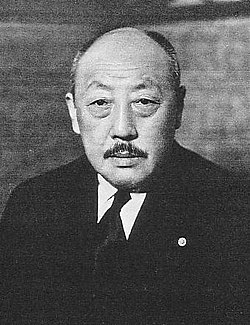Yosito Otuzi
Chief Minister of Senria Yosito Otuzi 尾辻美人 | |
|---|---|
 | |
| In office June X, 1927 – June 9, 1932 | |
| Preceded by | Position created |
| Succeeded by | Itio Fuziwara |
| Personal details | |
| Born | November 1, 1871 |
| Died | June 9, 1932 (60 years) |
| Nationality | Senrian |
| Political party | |
| Spouse | tbd |
| Children | tbd |
| Alma mater | tbd |
| Profession | Politician |
Yosito Otuzi (Senrian: 오뚜시요씨또, Otuzi Yosito; Gyoumon: 尾辻美人; May 3, 1884 - June 9, 1932) was a Senrian politician who is remembered primarily as the leader of the Reformed Government of Senria, a collaborationist government established by Xiaodong during the Great War.
Born in Sakata to an affluent family, Otuzi was a founding member of the Kousenkai and became a close associate of its founder, Ryuunosuke Miyamoto. After the Kousenkai and several other republican organizations were merged together into the Kyouwakai in 1910, however, Miyamoto increasingly began to favor former Daikyoumei member Isao Isiyama, who displaced Otuzi and became Miyamoto's protege; this caused a deep personal animosity between Otuzi and Isiyama, which was exacerbated by political disagreements between them. Though initially a leading figure on the republican side during the Senrian Revolution, Otuzi left the Kyouwakai after Isiyama succeeded Miyamoto as Speaker. After leaving the Kyouwakai, Otuzi became increasingly enamored with functionalism, which he saw as a model for a Senrian "national reconstruction".
After the outbreak of the Great War, Otuzi became a leading collaborator for the invading Xiaodongese forces; with Xiaodongese permission, he formed the functionalist Party of National Reconstruction and was named Chief Minister of the Reformed Government of Senria by Lu Keqian. Though nominally the regime's head of state, Otuzi held little effective power, and largely served as a rubber stamp for Xiaodongese military leaders. After unsuccessfully objecting to Xiaodongese efforts to partition Senria, Otuzi was regarded with increasing contempt by Xiaodongese authorities; Qiu Hanjie, fearing Otuzi would attempt suicide as it became clear that Xiaodongese forces were going to be driven from Senria, ordered him placed in solitary confinement at the Rokkaso Extermination Zone in April 1932. Otuzi was captured by Senrian forces when they liberated Rokkaso on June 6, given a two-day show trial under the personal supervision of Katurou Imahara, and executed for high treason on June 9.
Otuzi has been widely vilified since his death. He is regarded in Senria as an archetypal traitor for his collaboration with Xiaodong, and for his acquiescence to the perpetration of the Senrian Genocide by Xiaodongese forces. As a result of this, his relationship with Ryuunosuke Miyamoto and role in the early Senrian Revolution have typically been minimized, which has been criticized by some non-Senrian historians.